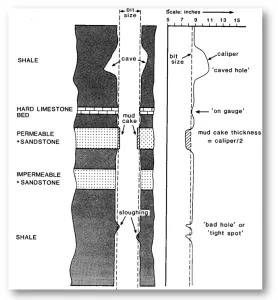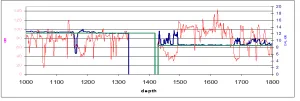The Caliper Log is a tool for measuring the diameter and shape of a borehole. It uses a tool which has 2, 4, or more extendable arms. The arms can move in and out as the tool is withdrawn from the borehole, and the movement is converted into an electrical signal by a potentiometer.

In the two arm tool, the borehole diameter is measured. This is shown in track 1 of the master log together with the bit size for reference. Borehole diameters larger and smaller than the bit size are possible. Many boreholes can attain an oval shape after drilling. This is due to the effect of the pressures in the crust being different in different directions as a result of tectonic forces. In oval holes, the two arm caliper will lock into the long axis of the oval crosssection, giving larger values of borehole diameter than expected. In this case tools with more arms are required.

In the 4 arm (dual caliper) tool, the two opposite pairs work together to give the borehole diameter in two perpendicular directions. An example of a 4 arm tool is the Borehole Geometry Tool (BGT). This has 4 arms that can be opened to 30 inches (40 inches as a special modification), and give two independent perpendicular caliper readings. The tool also calculates and integrates the volume of the borehole and includes sensors that measure the direction (azimuth) and dip of the borehole, which is useful in plotting the trajectory of the borehole. In the multi-arm tools, up to 30 arms are arranged around the tool allowing the detailed shape of the
borehole to be measured.
Some of the other tools in this course have sensors attached to pads that are pressed against the borehole wall. The pressing device is also a form of caliper, and so caliper information can sometimes also be obtained from these tools.